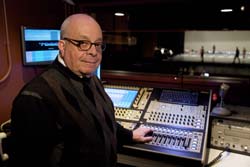
The desk proved to be the right solution for the theatre.
Not only did it physically meet the requirements for the space, but also could also handle the sound enhancement and reinforcement required by the City Opera and the New York City Ballet, who are the two main tennants of the theatre.
“Even though I’m from the old world of the theatre,” Jacob laughed, “I was adamant that we had to go digital.”
“It was the thing to do, even though I was scared to death of what could happen between layer one and two.”
“But the SD8 has proven that, without difficulty, I could sit down and make sound out of it. And if I can do it, anyone can!”
The primary function of the SD8 is to provide 14 channels or so of orchestral microphones that feed the onstage monitors for the dancers and singers, and another 6-8 area mics depending on the show or the opera, to feed backstage program, listening-impaired system, and various program needs throughout the building.
“We are using internal effects in the desk for some reverbs, a lot of the audio delay and EQ functions,” Jacob details, “but some of the other internal effects haven’t gotten a lot of use—not to say that that we’re not going to use them in the future, but we’ve got no absolute requirements for them at this point.”
In addition, the SD8 is used for the stereo direct-to-disc archival recordings of each of the first performances. “The Ballet records on DVD and the Opera records directly to audio,” adds Jacob, “and so we have a simple stereo mix out of the desk to those audio capturing devices.
Also, in the renovation, both companies desired to have a complete high definition audio/video capture suite included so they can do their Webcasts, TV broadcasts and archival recording for both DVD and 5.1 audio, so we do a stereo feed back and forth to them, but they’re recording to multi-channel audio capture that is totally separate to our usage of the SD8.”
Since its installation last year, the SD8 has proved a great fit for both the theatre and for Autograph. “For us,” says Mead, “it was so important to develop the relationship with DiGiCo, A2D and Abe, and it proved to work out well.”
“We loaned desks for a while, did a few productions and made sure the desk worked well work for them, and then we were there for them when it came time to purchase.”
“I have a great deal of respect and trust in the personnel behind DiGiCo’s manufacturing, and in my lengthy relationship with Autograph’s Lew Mead and Andrew Bruce. With the quality of sound that we were able to achieve previously with the D5T, it seemed that the SD8 would be the natural progression.”
“We’ve had it in operation since last November and it has proven over and over again to be exactly what we wanted. The sound has become a vital part of the theatre; I think it’s now the fourth design element—aside from costume, scenery and lighting—and in some instances, is as important as anything else. It allows producers to do productions with the benefit of a sophisticated sound reinforcement system.”
Lincoln Center for the Performing Arts Website
